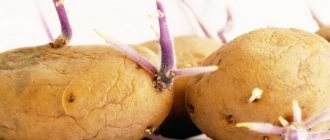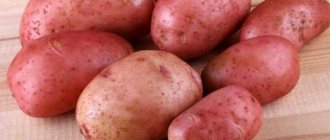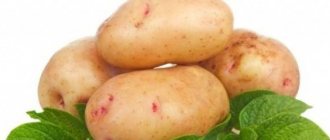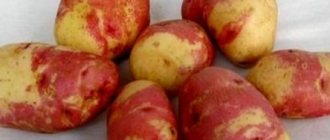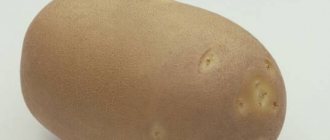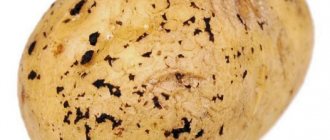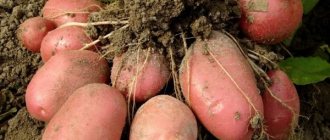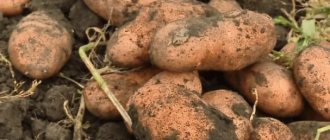Potato diseases and insect pests
The variety is extremely resistant to diseases and pests.
It shows excellent immunity to blackleg, wrinkled mosaic, potato cancer, and common scab. If the care rules are not followed, you may be exposed to:
- Late blight. This disease can spread both to tubers and to the above-ground part of the bush. Root crops begin to rot, dark spots form on the leaves, which subsequently lead to rotting of all greenery.
- Mold. The causes of mold on root crops are considered to be excessive soil moisture.
The development of late blight can be prevented by spraying the bushes with Fitosporin. In advanced cases, the plant is treated with modern insecticidal preparations.
Did you know? A record potato harvest was harvested in 1765 in Novgorod. Then, from 45 kg of seed material, 3 tons of 740 kg of fruit were obtained.
As for pests, Slavyanka is most often subject to “attacks”:
- Colorado potato beetle. It eats potato tubers and greens, due to which the bush slows down its growth and development.
- Wireworm. This parasite, eating everything in its path, forms numerous through holes and small grooves on the skin in the root crops, which negatively affects the taste and aesthetic properties of the tubers.
Diseases and pests
"Slavyanka" has sufficient resistance to major diseases. Such as:
- Potato cancer;
- Cyst nematode;
- Common scab.
The table shows data on the growing season of different potato varieties:
| Name | Variety | Days |
| Nikulinsky | Late ripening | 115-120 |
| Cardinal | Late ripening | 110-120 |
| Rocco | Late ripening | 100-115 |
| Kiwi | Late ripening | 120-130 |
| Ivan da Marya | Late ripening | 115-130 |
| Slav | Late ripening | From 125 to 140 |
| Borovichok | Early ripening | 70-90 |
| Elmundo | Early ripening | 70-80 |
| Felox | Early ripening | From 65 to 70 |
| Bellarosa | Early ripening | From 50 to 70 |
| Natasha | Early ripening | From 70 to 80 |
| Karatop | Extra early | From 60 to 65 |
| Riviera | Extra early | From 40 to 80 |
| Zhukovsky early | Extra early | 60 to 70 |
| Farmer | Extra early | From 50 to 60 |
| Minerva | Extra early | 45-50 |
| Crane | Mid-late | From 100 to 120 |
| Sorcerer | Mid-late | 80-90 |
| Mozart | Mid-late | From 100 to 180 |
| Ramona | Mid-late | From 80 to 100 |
| Limonka or Picasso | Mid-late | 120-130 |
| Yanka | Mid-early | 90-100 |
| Giant | Mid-early | From 80 to 100 |
| Tuscany | Mid-early | 70-90 |
| Purple Haze | Mid-early | 90-100 |
| Openwork | Mid-early | 75-85 |
Practically not susceptible to various viruses. Preventive measures:
- Against late blight they are treated with preparations containing copper;
- Spray with phytosporin against rot and fungus, and properly prepare the soil for planting;
- When bushes are damaged by aphids, Colorado potato beetles, and thrips, they are sprayed using insecticides. Keeping an interval of several days;
HELP: Infected tops are cut off a few days before harvest.
- Treated tubers and soil before planting will save you from wireworms. When choosing seed material, the use of damaged tubers is not allowed.
Characteristic
“Slavyanka” is a late-ripening table variety. From planting to harvesting 125-140 days. The variety is suitable for industrial cultivation or planting in personal plots. The yield is excellent; from 1 hectare you can harvest from 180 to 330 centners of selected potatoes.
The yields of other varieties for comparison are presented in the table below:
| Variety name | Productivity |
| Slav | 180-330 c/ha |
| Lorch | 250-350 c/ha |
| Mistress | 180-380 c/ha |
| League | 210-350 c/ha |
| Handsome | 170-280 c/ha |
| Svitanok Kyiv | up to 460 c/ha |
| Borovichok | 200-250 c/ha |
| Lapot | 400-500 c/ha |
| American | 250-420 c/ha |
| Colombo | 220-420 c/ha |
| Red Fantasy | 260-380 c/ha |
The quantity and quality of root crops depends on the nutritional value of the soil and climatic conditions. The maximum yield reaches 400 centners per hectare. Harvested potatoes are stored for a long time without losing high commercial quality and richness of taste.
Read more about storing potatoes: terms, temperatures, places and problems. And also how to properly store root vegetables in winter, in vegetable stores and cellars, in the apartment and on the balcony, in boxes, in the refrigerator, cleaned.
The bush is of medium height, moderately spreading, with abundant formation of green mass. Stems are branched, few in number. The leaves are dark green, large, strongly dissected, with noticeable veins, slightly wavy edges and weak fluff.
The number of berries is small. The compact corolla is made up of bluish-violet flowers with white tips. The root system is well developed, 12-15 selected tubers are formed under each bush. The amount of non-commodity items is minimal.
Potatoes are of the intensive type and require frequent feeding and moderate watering. The variety prefers alternating mineral fertilizers and organic matter. Very light sandy soil is desirable.
Read more about how to feed potatoes, when and how to apply fertilizers, how to do it correctly when planting, what fertilizers are the best.
Tubers do not accumulate nitrates, and seed material is not subject to degeneration. Root crops do not cope well with mechanical damage; care is needed when harvesting.
Consumers note the high taste qualities of root vegetables. The potatoes don't boil enough, the tubers retain their neat shape. The taste of cooked potatoes is rich, slightly sweet, without being too dry or watery.
The low starch content prevents root vegetables from darkening during cutting and cooking; finished dishes have a pleasant golden-yellow color. Suitable for making soups, side dishes, baking, stuffing. The tubers make delicious chips and French fries.
Growing
Growing Slavyanka in your garden is no more difficult than growing potatoes of any other variety. Initially, the seeds are purchased, then part of the harvest can be left for planting next year. At the same time, there is no need to use too small potatoes as seeds, this will lead to degeneration and reduction of tubers in subsequent years. But it is permissible to cut the tubers immediately before planting so that they have several eyes.
The seeds are left with strong and healthy tubers without mechanical damage or rot. Before storage, they are greened - that is, kept in the sun for 2-3-4 days, until the tubers turn green. Solanine, which is formed in them under the influence of ultraviolet radiation, prevents rot and spoilage of tubers; you cannot eat such potatoes, but for seeds this is exactly what you need.
In spring, it is better to plant sprouted potatoes in the ground with at least small sprouts. To do this, before planting, take it out of the basement into a warm room and slightly moisten it, or cover it with a damp cloth.
For rapid germination, protection from pests and diseases, tubers are treated with growth stimulants.
Potatoes are planted according to the following scheme: the distance between the bushes is 35 cm, the distance between the rows is 70-75 cm. They are watered 3-4 times per season, depending on the amount of precipitation. According to gardeners, even with a short-term drought, Slavyanka will continue to grow and develop, and will produce a good harvest.
The soil is fertilized in the fall by adding humus, superphosphates and ash, in which case it will no longer be possible to feed the potatoes during the growing season.
Let's summarize
- Slavyanka is a pink, late-ripening potato variety of Ukrainian selection. In Russia, it is grown in the southern regions, up to the Moscow region and even a little higher.
- The strengths of this variety are considered to be the good keeping quality of the tubers, trouble-free transportation of the crop over long distances, and the vitality of the bushes (your harvest will not be destroyed by temperature fluctuations or short-term drought).
- The disadvantage of Slavyanka is its thin peel. If you cut or even scratch the tubers during digging, you should immediately send them for food - they will not lie in the cellar, and after a couple of weeks they will begin to rot, simultaneously infecting healthy potatoes lying nearby.
Features of care
The characteristics of the Slavyanka variety indicate that with a minimum of effort in agricultural technology, the plant grows well almost throughout the entire territory of Russia. But in order to improve the quality of yield, the crop will need to create favorable conditions at different phases of development.
General recommendations for carrying out agricultural practices:
- Watering the soil. Slavyanka, compared to similar tuberous plants, has the least need for moisture. It is enough to irrigate the soil before sprouting, during budding and during flowering of the crop.
- Mulching the soil. During a period of long drought, it is recommended to spread a protective layer of rotted grass, leaves or pine needles between the potato bushes.
- Weeding the area. The best option for removing weeds is considered to be the manual method. If you use a dry one, the result of weeding will decrease several times. This is justified by the fact that the root system of cut plants produces new shoots.
- Hilling up bushes. This technique will increase the volume of loose soil for the development and growth of tubers. As a rule, hilling of plants is carried out before the tops close.
- Spraying potatoes. To avoid deformation of bushes from pests and diseases, at the first sign of them, gardeners recommend immediately using pesticides.
When growing potatoes, do not forget about fertilizing. Organic fertilizers together with mineral complexes will have a beneficial effect not only on the development of the plant, but also on the formation of tubers.
General description of the variety
Slavyanka is a mid-early species, ripens in 100-120 days. Among the main characteristics are:
- dining appointment;
- 13-15 tubers under one bush;
- average weight of potatoes – 100-250 g;
- keeping quality is up to 95%;
- 11-13% starch;
- the peel is pink with a purple tint;
- cream-colored pulp;
- resistance to golden potato nematode, cancer, mosaics, leaf curl.
Characterized by high productivity. The average is 250-300 c/ha. The maximum volume of potatoes harvested from each hectare is 400 quintals.
Note! The number of dug tubers is not affected by the weather. The volume of the harvest depends primarily on the quality of care and compliance with the rules of agricultural technology.
History of appearance
The Slavyanka variety was developed in Ukraine at the Kirovograd Institute of the Ukrainian Academy of Agrarian Sciences. Breeders used virus-free seed material during their work. The species appeared in the state register in 2009. Since that time, Slavyanka has been actively grown in Russia.
The plant is intended for planting in the Central Black Earth region. But in Russia this variety is grown throughout the country.
Taste characteristics
Tubers are formed of an oval oblong shape. The peel is pink. Each potato weighs 90-170 g. There are small eyes on the surface, which makes peeling convenient.
The pulp contains many useful components: amino acids, B vitamins, healthy proteins. The Slavyanka variety is intended for table use. It is used for chips, first courses, casseroles, French fries, and vegetable mixtures. It does not boil over and retains its shape after heat treatment.
Characteristics of the bush
The bushes are of medium height (up to 0.5 m) and have a spreading appearance. There are few stems, but they are branched. Greenery is plentiful. The foliage is dark-bright in color, the edges are slightly drooping, split. When flowering, not too many inflorescences are formed. They have a slight bluish-purple hue with a white tip.
The root system is well developed, up to 15 tubers are formed under each bush. There are few small non-marketable potatoes.
Advantages and disadvantages of the variety
Slavyanka has a number of positive and negative qualities that are taken into account when choosing.
Advantages of the variety:
- excellent taste characteristics;
- marketability, correct form;
- good keeping quality;
- resistance to most potato diseases;
- ease of care;
- undemanding to germination conditions;
- friendly ripening of tubers;
- high yields.
Slavyanka has a number of disadvantages that must be taken into account in order to avoid difficulties when growing and caring for it. The tubers have poor resistance to shock, so after digging they immediately sort through the potatoes, removing damaged specimens.
Note! Another drawback is that to get a good harvest you need high-quality fertile soil.
Comparison with other varieties
To compare Slavyanka potatoes with other mid-season varieties, a table is provided where you can learn about the advantages and disadvantages of a similar crop:
| Variety | Ripening time | Productivity | Advantages | Flaws |
| Slav | 100-120 days | up to 400 c/ha |
| Low resistance to mechanical damage. |
| Tuleevsky | 80-110 days | 180-500 c/ha |
| Susceptibility to cyst nematode. |
| Rocco | 100-150 | 350-400 c/ha |
| It is poorly stored in cellars where there are no proper conditions. |
| Aurora | 60-80 days | 215-400 c/ha |
| Requires a high level of agricultural technology. |
| Rosara | 65-70 days | 415 c/ha |
| Suffers from late blight of tops. |
Potato Slavyanka: variety description, photo
The Slavyanka potato variety was developed in Ukraine. In Russia, it was included in the state register relatively recently, in 2009, with zoning in the Central Black Earth region. But in fact, potatoes are grown over a much wider area due to their excellent varietal and taste qualities.
The Slavyanka variety is widespread throughout Ukraine, as well as in many regions of Russia.
Potato bushes of this variety grow quite large, about 50 cm, and have medium spreading. Although not very many stems appear, they are well branched and heavily leafed. The leaves themselves are slightly wavy and slightly pubescent along the edges. They grow quite large, dissected and have a dark green color. This variety blooms profusely, but very briefly, with small violet-blue inflorescences with characteristic white spots on the edges of the petals.
Slavyanka has an excellent ability not to accumulate nitrates in tubers, and also not to degenerate during long-term cultivation.
Slavyanka is a late-ripening potato variety. From the moment of planting to the day of ripening, it takes from 120 to 140 days. At the same time, the harvest ripens together.
Characteristics
The main advantage of this potato variety is its extremely high yield. On average, from one planted acre you can get about 250–300 kg of harvest, and sometimes this figure reaches 400 kg. That is why Slavyanka is so loved by both ordinary summer residents and professional farmers. It is also worth saying that the yield of the variety is almost independent of weather conditions, but proper care and adherence to agronomic tricks can easily increase the average volume indicators.
The Slavyanka variety is distinguished by its high yield
Another important positive feature of the Slavyanka variety is the high degree of preservation of the crop during storage. Potatoes do not lose their marketability and taste even 7 months after harvest
Among other things, this variety is very unpretentious in regular care, as it is extremely resistant to common potato diseases. Among them:
- blackleg;
- leaf curling;
- wrinkled mosaic;
- golden nematode;
- potato cancer.
You should only pay attention to protecting the plant from late blight, and both tubers and the above-ground part of the plant can be susceptible to this disease.
Fruit
A pleasant feature of this potato variety is the fact that the tubers grow very large, and there are almost no small fruits at all. A mature potato weighs about 90–180 g and has an oval, somewhat oblong shape. The skin of the fruit is smooth, rather thin, and has a uniform pinkish-violet hue. The neat appearance and even shape make potatoes of this variety extremely attractive for sale. The eyes on it are small and rare, which makes the variety extremely convenient for cleaning and processing.
Among the fruits of Slavyanka there are almost no small root vegetables
In terms of taste, the variety is rated as good. During heat treatment, the root vegetable retains its shape and almost does not fall apart. The inside of the potato is cream-colored; by the way, the starch content in the pulp varies from 11 to 13%. This low percentage allows Slavyanka to be an excellent base for making chips and French fries, and also to be successful when stuffed and baked.
Fruit characteristics
The tubers of the Slavyanka potato variety grow very large. There are practically no small ones. They are oblong-oval in shape. The color is purple-pink. The characteristics of the tubers are as follows.
- The weight of one tuber varies from 90 to 175 grams.
- The eyes are small and superficial, very convenient for peeling potatoes.
- The skin is smooth, thin, evenly colored.
- The flesh is creamy.
- The starch content in tubers is low - from 11 to 13%.
- The taste is characterized as very good.
- Marketability - 88-99%.
- Keeping quality - 95%.
- Tubers contain a large amount of B vitamins, amino acids, and proteins.
Slavyanka potato tubers have a very neat, even shape, ideal for sale. The potatoes are slightly boiled, the tubers retain their shape after heat treatment. Due to the low starch content, potatoes of this variety are ideal for making French fries and chips. It can also be used for baking and stuffing.
Description, general information
The Slavyanka variety is a product of Ukrainian breeders working at the Kirovograd Institute of the UAAS. The variety was bred at the beginning of the new millennium using virus-free seeds. It was recorded in the Russian State Register in 2009, and since then it has been actively used in both Ukraine and Russia.
It is grown in all regions of the country where potatoes can be grown at all, and in its homeland, that is, in Ukraine, it has generally become one of the most popular. At the same time, late fruit ripening limits the use of the variety in the northern regions of the country, where frosts begin as early as September. At least 4-5 months must pass from planting to harvest.
What can you say about Slavyanka? The bushes are quite tall - up to 50 cm in height, there are not many stems, but they are branched and well-leafed. The leaves are green, large, with clearly visible veins and slightly wavy edges. The flowers are purple with white spots on the edges.
The tubers in the bush are approximately the same size, large, oval in shape, the skin is pink, the flesh is creamy. Their weight is 90-175 grams, the eyes are small and numerous.
There is not very much starch in the tubers - 11-13%, so potatoes cannot be called crumbly; during heat treatment they retain their shape well. It can be used for stuffing, making French fries and baking.
The even shape of the potatoes makes it possible to use a potato peeler if you need to peel a large number of tubers at once. In terms of taste, Slavyanka has a solid four from tasters on a five-point system.
The high yield of Slavyanka - up to 300 centners or more per hectare - makes it attractive for farmers and gardeners who have set themselves the goal of providing their family with potatoes.
Naturally, in order to obtain an excellent harvest, it is necessary to comply with all agrotechnical rules; to a large extent, the weather also influences the yield. However, no one will be left without a harvest with Slavyanka.
Harvested potatoes can be stored for a long time, but only in a dry and cool room with a temperature no higher than +2 degrees and air humidity no higher than 65%. Under such conditions, the quality and taste of the fruit will remain the same until spring. The keeping quality of potatoes is within 95%.
The variety is resistant to potato cancer, nematode, mosaic, and blackleg. However, the bushes must be treated with special means against the Colorado potato beetle and late blight.
As you can see, Slavyanka has more advantages than disadvantages. However, there are some, including the poor preservation of tubers cut during digging. Therefore, before storing potatoes, they sort through them, inspect them, and remove damaged tubers. They are the first to be recycled.
Advantages and disadvantages
The main advantages of the variety include:
- high taste qualities of tubers;
- excellent yield;
- friendly ripening of root crops;
- good keeping quality;
- decent commercial qualities;
- versatility of tubers;
- unpretentiousness to weather changes, short-term drought;
- resistance to major diseases.
The disadvantages of the variety include the insufficient resistance of tubers to mechanical damage. Potatoes spoiled during digging are discarded.
Slavyanka is a potato that is grown almost everywhere in our state.
- And this is not surprising, because it has a number of advantages:
- high yield rates;
- excellent taste and aesthetic qualities of the fruit;
- resistance to various climatic conditions;
- low maintenance requirements;
- resistance to many diseases characteristic of nightshades.
- Among the disadvantages of the variety, experienced farmers note:
- low resistance to mechanical damage;
- demanding on the frequency and quantity of fertilizing.
The Ukrainian potato variety Slavyanka is widespread due to a lot of advantages, but there are several negative aspects.
| pros | Minuses |
| Great taste | Successful growth requires good soil. |
| High yield | Tubers are not resistant to mechanical stress, which makes harvesting and transportation difficult |
| Simultaneous ripening of fruits | Damaged root vegetables spoil quickly |
| Resistance to fungal infections | |
| Easy to care for | |
| High keeping quality | |
| Attractive appearance |
The Slavyanka potato variety has numerous advantages that allow it to enjoy great popularity not only among ordinary gardeners, but also among farmers.
- Excellent yield;
- High taste qualities of tubers;
- Friendly maturation;
- Resistance to major diseases;
- Unpretentiousness to the vagaries of the weather;
- Good keeping quality;
- Good commercial quality.
However, this variety also has a drawback - it is not resistant to mechanical damage. And if the cut tubers end up in storage, they will quickly begin to rot. And since harvesting technical conditions do not always allow one to avoid mechanical damage, it is necessary to carefully sort out the tubers of this variety before storing them.
Among the advantages are:
- harvest volume;
- strong resistance to infection;
- immunity to weather changes;
- taste characteristics.
Negative points include:
- high sensitivity to mechanical damage;
- requires frequent and sufficient feeding during the growth period.
Slavyanka potatoes have a lot of advantages. The main ones are the following:
- good taste;
- high productivity;
- early ripening;
- the fruits have a marketable appearance and neat shape;
- the crop can be stored during the winter;
- the variety is unpretentious to temperature changes;
- resistance to many diseases.
The main disadvantages are the following:
- the variety is not resistant to mechanical damage. Tubers spoiled during harvesting cannot be stored;
- tubers can be affected by late blight.
As mentioned above, the Slavyanka variety is loved by gardeners not only in their homeland, but also in Russia. Among the main advantages of potatoes, summer residents highlight:
- friendly fruiting;
- high yield rates;
- taste and commercial qualities of root crops;
- unpretentiousness to weather conditions;
- long shelf life;
- versatility;
- simple agricultural technology;
- good immunity to major tuber diseases.
Oddly enough, among such a large number of advantages, the Slavyanka variety has no significant disadvantages. The only thing worth paying attention to is that potato tubers are not resistant to mechanical damage. Therefore, you need to be extremely careful when digging the crop.
Features of cultivation
Tubers are planted in well-warmed soil, this guarantees friendly shoots. Before planting, the potatoes are pickled, the soil is thoroughly loosened, and humus or wood ash is laid out in the holes. The planting scheme is standard, leaving 35 cm between bushes; row spacing of at least 75 cm wide is required.
For successful potato growth, dosed watering is required. The ideal option is drip moistening, which does not contribute to stagnation of water in the soil.
The variety tolerates short-term drought, but with a constant lack of moisture, the tubers become smaller and the yield decreases.
During the season, it is recommended to apply a complete mineral fertilizer with a predominance of potassium, and also water the plantings 1-2 times with diluted mullein or bird droppings.
Hilling and mulching the row spacing will not hurt. Read our articles about whether it is necessary to hill up potatoes, how to do it manually or with a walk-behind tractor, and whether it is possible to get a decent harvest without weeding and hilling.
Tubers are sensitive to mechanical damage. For industrial digging, it is recommended to use side-grab combines. Hand digging requires extreme care. Damaged tubers are not stored. The harvested crop is laid out to dry on the boundary or under a canopy.
Tubers store well in a cool, dry place. Frequent reassembly is not required. At normal temperatures, potatoes do not lose their consumer properties for several months.
On our website you will find many useful articles. What do you know about spraying plantings?
Read all about why and how to use herbicides, fungicides and insecticides when growing potatoes.
Landing rules
Slavyanka potatoes should be planted when the air temperature at night does not drop below +5 degrees and the soil has warmed to a depth of 15 cm. Therefore, the second half of May is considered the optimal period.
For Slavyanka, you should choose a well-lit area where moisture does not stagnate. With a lack of light, the bushes stretch out and the size of the tubers becomes smaller. To get a good harvest, site preparation must begin in the fall. During this period, deep plowing should be carried out and humus should be added at the rate of 200 kg per hundred square meters.
With the arrival of spring, plowing must be repeated and the soil surface leveled so that the tubers emerge evenly. It is recommended to make holes for Slavyanka potatoes at a distance of 30 cm, and leave at least 60 cm between rows. This planting promotes uniform lighting, ventilation and high-quality hilling of the bushes.
You need to add nitroammophoska or wood ash to each hole. And then thoroughly mix the fertilizer with the soil.
Characteristic
The variety is distinguished by productivity, unpretentiousness to the soil, and endurance to weather changes. Slavyanka shows a high degree of preservation of tubers - they are stored for 7-8 months.
Total information
Slavyanka is included in the group of table varieties.
The variety is defined as mid-late or late-ripening. Ripening occurs smoothly, the harvest time depends on the growing regions. The further south the territory, the earlier root crops are harvested. The harvest begins after 100 days. In temperate northern regions, 125-140 days pass before collection.
Among the advantages are large tubers over 100 g, high productivity of bushes, resistance to pathogens.
Description of appearance
Slavyanka bushes are compact and small in size. There are few stems and have a semi-erect shape.
Escapes
The vegetation of the stems is moderate, although a lot of leaves are formed. The inflorescences are bluish-violet in color with a white edge, there are few berries. The roots branch and develop well, producing more than 12 selected tubers.
| Description of shoots | Peculiarities |
| Stems height | 40-50 cm. |
| Spreading | Moderate. |
| Escapes |
|
| Leaves |
|
Roots
From 10 to 15 large potatoes ripen on 1 bush. Tubers are ideal for making purees, frying, stewing, and boiling whole.
| Indicators | Characteristic signs |
| Form |
|
| Peel |
|
| Weight of root vegetables | 90-250 g. |
| Pulp |
|
| Starch level | 11-13%. |
| Eyes |
|
Seeding rate and yield per 1 hectare
Attention! From 35 thousand to 35.4 thousand seed tubers are planted per 1 hectare. With a mass of 1 tuber of 70-90 g per 1 ha, 2.8 tons of planting material will be required. Yield indicators:
Yield indicators:
- Minimum 150-175 c/ha.
- Average within 180-330 c/ha.
- High 400 centners from 1 hectare or more.
Taste qualities
Dishes from Slavyanka are distinguished by a rich sweetish taste, without wateriness or excessive dryness. Due to its delicate texture, it is used in various dishes.
Chemical composition
Potato components:
- 74-75% water.
- 11-13% starch.
- 2% protein.
- 1% sugar.
- 0.2% lipids.
- 1.5% fiber.
- 0.16% acid.
- other substances.
Slavyanka is rich in minerals, the most important of which are potassium, iodine, manganese, and magnesium. The variety is valued for its high level of vitamins C, B1, B6. Contains antioxidant substances - polyphenols and carotenoids.
Resistance to diseases and pests
| Resistance to pathogens | Diseases and pests |
| High |
|
| Moderate | Phytophthora of root crops and bushes. |
| Low | Gray apical rot. |
Where is it used?
After cooking the potatoes:
- Crumbly.
- Gentle.
The average starch content in tubers gives dishes a pleasant flavor without being watery. Tubers do not fall apart during heat treatment. The pulp does not darken and retains its appetizing appearance. Slavyanka is recommended for children's and dietary cuisine.
Universally applicable:
- Puree.
- Cooking in the skin.
- Baking.
- Extinguishing.
- Fillings.
- Bakery.
- Fries.
- Chips.
In which regions of Russia is it usually grown?
SovetSlavyanka is zoned for areas with a temperate climate. It is successfully cultivated in the climatic conditions of the Central Black Earth region.
The variety actively bears fruit:
- In the Urals.
- In outskirts of Moscow.
- In the Volga region.
Technology for growing potatoes "Slavyanka"
Many gardeners have the misconception that it is enough to simply plant potatoes in the ground, do a minimum of weeding and hilling, and then harvest in the fall
This is why the harvests are small, because no attention is paid to compliance with agricultural technology, and when planting, seed material of unknown potato varieties is used. At the same time, by introducing intensive technologies into your farm, you can provide not only yourself with potatoes, but also sell the surplus in the markets
The “Slavyanka” variety is a variety for high-intensity production, so the requirements for cultivation are also high, although in skillful hands the variety is not whimsical.
Fertilizing a personal plot with organic matter should be regular: according to the principle, what is taken must be replaced. Therefore, at the end of the harvest, humus is added to the ground. Don’t forget about fertilizers with a high content of phosphorus, nitrogen, and potassium.
Also, compost is prepared separately in a large box to fertilize the holes before planting potatoes. In August-September, cut grass, sawdust, manure, droppings, etc. are collected in a barrel (box). After filling the barrel with compost, it is treated with preparations such as “Baikal”. They contain beneficial microorganisms that, within a few months, form high-quality biological fertilizer from compost.
You may be interested in: How to grow potatoes in bags: step-by-step technology, reviews
It is important to remember that potatoes are planted provided that the soil temperature has reached at least 7-10 ºС. As a rule, this is the last ten days of April, in some regions of Russia - later
Thanks to this, the potatoes not only heat up to the optimal temperature, but also have the opportunity to use the moisture that has accumulated over the winter from melting snow.
Based on the indicated time frame, potatoes are vernalized 3-4 weeks before planting. To do this, the tubers are laid out in 1-2 layers in cardboard boxes and placed in a heated room with sufficient access to sunlight. Under the influence of light and heat, the tubers sprout, which after planting will accelerate the germination of potatoes.
Tubers of the “Slavyanka” variety are also recommended to be treated with biologically active preparations “Fumar” and its analogues, which promote healthy potato growth without the unnecessary use of chemicals.
In the spring, the area for planting potatoes is milled, turning the soil into loose dust - what is needed for planting potatoes. It is recommended to plant “Slavyanka” potatoes according to a 70x30 cm pattern, thanks to which on one hundred square meters you will get approximately 450 bushes, which will yield 1-1.5 kg each.
Organic compost, prepared in advance in the fall, is added to the dug holes, which by spring has acquired the optimal consistency and nutritional composition. The depth of planting seed potatoes is no more than 8-10 cm. After planting, the holes are dug in and the soil on the surface is carefully leveled with a rake.
“Slavyanka” produces the first shoots at the end of the second week after planting the potatoes. After these shoots appear, a convenient opportunity arises to carry out the first weeding, because the weeds appeared in the garden much earlier. In general, the number of weedings is not strictly regulated, as it is performed as necessary.
An integral part of the Slavyanka care technology is hilling the bushes, which is carried out 2 times. The first time is when the bushes reach a height of 15-20 cm, the second time is before flowering. When hilling bushes along the beds, high ridges are formed, no more than 20 cm in height. Hilling can be combined in time with weeding and loosening.
As for watering, it should be frequent, but not very abundant, as this is fraught with the development of fungal diseases, especially late blight. Optimal watering is provided by a drip irrigation system. In its absence, rain installations are used.
The “Slavyanka” variety responds responsively to fertilizing during the growing season. Considering the late ripening period of the variety, fertilizing is applied about 3-4 times. It is recommended to alternate the use of organic and mineral fertilizers. When forming a mixture of mineral fertilizers, you need to include superphosphates, potassium salts, and a little fertilizer containing nitrogen.
Important! Fertilizing should not be excessive; it is better to apply it more often, but little by little. The Slavyanka harvest is carried out at the end of August - mid-September
At the same time, in no case should you postpone the digging date later, otherwise, after the first frost, the dug potatoes will not be stored for long
The Slavyanka harvest is carried out at the end of August - mid-September. At the same time, in no case should you postpone the digging date later, otherwise, after the first frost, the dug potatoes will not be stored for long.
Harvesting and storage
When the bushes begin to droop and wither, it is recommended to dig up one bush: if the skin of the potatoes has become strong, it is allowed to begin mass harvesting.
After harvesting, the tubers are left in the sun for several hours to dry. Then they are sorted out from rot and sorted into planting and feed material. Next, the potatoes are lowered into storage.
Vegetables are stored in basements, cellars, and cellars. It does not matter in which room the potatoes are stored, but it must be clean, ventilated and disinfected, the humidity in it is 80-95%, and the air temperature is +1-3 degrees.
Store potatoes in bags, nets, wooden boxes or compartments. You can also scatter it on the floor by first making a depression and pouring straw into it in a 10 cm layer.
Potatoes “Slavyanka”: description of the variety
| Variety name | Slav |
| general characteristics | mid-season table variety |
| Maturation period | 100-120 days |
| Starch content | 11-13% |
| Weight of marketable tubers | 90-250 gr |
| Number of tubers in a bush | 7-15 |
| Productivity | 180-330 c/ha |
| Consumer qualities | the taste is good and excellent, suitable for frying and preparing salads |
| Keeping quality | 95% |
| Peel color | red |
| Flesh color | cream |
| Preferred Growing Regions | Central Black Earth |
| Disease resistance | resistant to golden potato nematode, potato cancer pathogen, wrinkled and striped mosaic, leaf curl virus |
| Features of cultivation | loves feeding, otherwise unpretentious |
| Originator | Kirovograd Institute of Agro-Industrial Production UAAS |
The main characteristics of the potato variety “Slavyanka”:
- large tubers, weighing from 100 to 180 g;
- oval shape, elongated;
- root vegetables are smooth, neat, ideal for sale;
- the peel is pink-violet, evenly colored, thin, smooth;
- ocelli superficial, few, inconspicuous;
- the flesh is creamy when cut;
- starch content is average, up to 11.1 to 13.4%;
- high content of proteins, B vitamins, amino acids.
In the table below you can see what percentage of starch is contained in other potato varieties and compare them with this:
| Variety name | Starch content |
| Slav | 11-13% |
| Grenada | 10-17% |
| Sheri | 11-15% |
| Natasha | 11-14% |
| Zekura | 13-18% |
| Bullfinch | 15-16% |
| Timo | 13-14% |
| Spring | 11-15% |
| Molly | 13-22% |
| Giant | 16-19% |
| Santana | 13-17% |
We bring to your attention interesting information about the properties of potatoes.
Read about the dangers of solanine in tubers, whether you can eat sprouts and drink juice, and whether raw potatoes are healthy.
For your attention the potato variety “Slavyanka” in the photo:
Origin story
This variety was bred by Ukrainian breeders. The work was carried out by employees of the Kirovograd Agro-Industrial Institute; virus-free seed material was chosen for improvement.
It can be grown both on an industrial scale and in personal plots.
Registration in the State Register of the Russian Federation in 2009 , intended for planting in the middle zones (Central, Volga).
The table presents data on starch content in different varieties:
| Name | Variety | % |
| Slav | Late ripening | 11,1-13,4 |
| Cardinal | Late ripening | 15 |
| Rocco | Late ripening | 16 |
| Ivan da Marya | Late ripening | From 8 to 14 |
| Asterix | Late ripening | 17 |
| Borovichok | Early ripening | From 13 to 17 |
| Elmundo | Early ripening | From 11 to 14 |
| Felox | Early ripening | 16-17 |
| Bellarosa | Early ripening | 12 to 16 |
| Natasha | Early ripening | From 12 to 14 |
| Forty days | Extra early | From 11 to 15 |
| Karatop | Extra early | From 10.5 to 15 |
| Riviera | Extra early | 19,6 |
| Zhukovsky early | Extra early | From 10 to 12 |
| Farmer | Extra early | 12 |
| Crane | Mid-late | 14-19 |
| Sorcerer | Mid-late | From 12 to 15 |
| Mozart | Mid-late | No more than 20 |
| Grenada | Mid-late | From 10 to 17 |
| Melody | Mid-late | From 11 to 17 |
| Yanka | Mid-early | 14,8-15,4 |
| Giant | Mid-early | 16-19 |
| Tuscany | Mid-early | From 12 to 14 |
| Purple Haze | Mid-early | 14,4-17,2 |
| Openwork | Mid-early | From 14 to 16 |
Selection and description of this variety
Slavyanka is a late-ripening variety. From sending the seed tubers into the ground to harvesting, it takes about 140 days.
The yield of the variety is average: 1 hectare of garden will give you from 185 to 330 kg. Why is there such a discrepancy in the numbers? It’s simple: the size of the tubers (and therefore the final weight of the bags) is influenced by many factors - conditions in the region (amount of rain/drought), soil composition, fertilizing.
Bush. If you compare Slavyanka bushes with other varieties, they may seem less tall and more spreading. Potatoes bloom with purple flowers with white tips of the petals.
Tubers. Each bush produces from 12 to 17 tubers. Most often their size is the same, larger than average. The weight of the fruit fluctuates around 180 g. The tubers are oval, slightly elongated, their skin is pink (slightly violet). If you cut the tuber, you will see creamy pulp, not too dry, but it also cannot be called watery.
We must thank Ukrainian breeders from Kirovograd (UAAN) for this variety. Since 2009, the variety has been officially bred in Russia. At first they began to grow it in the Moscow region, but the more time passes, the further Slavyanka spreads throughout the country.
Advantages of Slavyanka
- The tubers last well until spring.
- The Slavyanka can easily handle transportation over long distances. This explains its popularity among farmers, who often transport their goods far beyond the region.
- Having dug up the crop, you will notice that there are almost no “peas”. In good years you will consistently see large tubers, in bad years - medium tubers.
- Thanks to their powerful rhizomes, the bushes survive heat and lack of moisture well.
- The variety is resistant to many diseases (such as nematode, black leg, wrinkled and tobacco mosaic, leaf curl, nightshade cancer), as well as temperature changes (even a difference in air temperature of up to 15 degrees will not kill it).
Potato sellers also claim that this variety does not accumulate nitrates.

